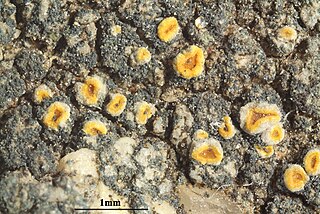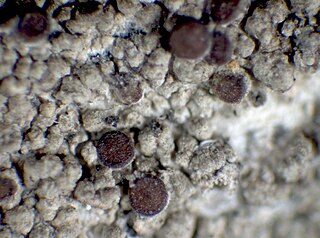Graphis marusae is a species of corticolous (bark-dwelling) crustose lichen in the family Graphidaceae. It is found in a relict tropical lowland rainforest in Veracruz, Mexico, growing in exposed understory.
Biatora pacifica is a species of corticolous (bark-dwelling), crustose lichen in the family Ramalinaceae. It is found in Russia, Japan, and South Korea, where it grows along the Pacific coast. It inhabits the bark of a variety of coniferous and deciduous plants.
Biatora radicicola is a species of corticolous (bark-dwelling) and saxicolous (rock-dwelling), crustose lichen in the family Ramalinaceae. It is found in various locations in Europe, where it grows in sheltered and humid microhabitats, often on exposed root bark at the base of trees.
Wilketalia is a fungal genus in the family Teloschistaceae. It is monotypic, containing the single species Wilketalia citrinoides, a saxicolous (rock-dwelling) crustose lichen found in the Bolivian Andes.
Solitaria is a fungal genus in the family Teloschistaceae. It contains a single species, the corticolous (bark-dwelling), crustose lichen Solitaria chrysophthalma.
Caloplaca sterilis is a corticolous (bark-dwelling), crustose lichen belonging to the family Teloschistaceae, described in 2011. It is primarily found in steppe and sand dune habitats in the Black Sea region, and has been recorded from Bulgaria, Romania, southwest Russia, and Ukraine. Caloplaca sterilis is characterised by tiny squamules/areoles with contrasting pale greyish-green to greenish soredia. It is easily overlooked and challenging to identify when completely sorediate and sterile, especially as its soredia do not contain the typical Sedifolia-grey pigment.
Megalospora austropacifica is a species of corticolous (bark-dwelling), crustose lichen in the family Megalosporaceae. It is found on the islands of Taveuni and Viti Levu in Fiji. It has a yellowish grey to whitish grey, glossy thallus that is thick and may appear slightly wrinkled or smooth, often with irregular cracks and small papillae containing conidiomata, but lacking isidia and soredia. Its apothecia are circular, up to 4.5 mm in diameter, with the disc evolving from concave to slightly convex and coloured from orange-brown to red-brown, surrounded by a thick, prominent margin.
Caloplaca nothocitrina is a species of saxicolous (rock-dwelling), crustose lichen in the family Teloschistaceae. Its thallus is up to 8 mm in diameter and deep yellow in colour. It comprises small dispersed areoles, occasional concave soralia, and circular apothecia with a bright yellow margin and a dull dark yellowish or brownish disc.
Amandinea pilbarensis is a little-known species of crustose lichen in the family Physciaceae, First described in 2020, it is found in Australia. It is similar to Amandinea polyxanthonica, but can be distinguished by its smaller ascospores and the presence of calcium oxalate and thiophanic acid in the medulla.
Fellhanera ivoriensis is a species of foliicolous (leaf-dwelling) lichen. First described in 2001, this species is distinguished from its relatives in the Fellhanera by its soredia-covered thallus and the characteristics of its apothecia. It is native to the Ivory Coast in West Africa.

Kuettlingeria soralifera is a saxicolous (rock-dwelling), crustose lichen species in the family Teloschistaceae, first described in 2006. It is similar to Kuettlingeria xerica but distinguished by the presence of soredia on its thallus.
Elixjohnia jackelixii is a species of saxicolous (rock-dwelling), crustose lichen in the family Teloschistaceae. It is found in Australia and New Zealand. The lichen is characterised by its unique multilayered appearance with outer sterile rings that are brownish or greenish-yellow and inner areoles that are whitish, yellowish, or greyish, often cracked to reveal the medulla underneath. Its fruiting bodies, or apothecia, are typically attached directly to the thallus and vary in colour and shape.
Filsoniana ferdinandmuelleri is a species of saxicolous (rock-dwelling), crustose lichen in the family Teloschistaceae. It is found in Australia. The lichen has a squamulose (scaly) thallus, with a range of bright yellow to greenish-yellow and brownish-orange colours in its soredia and apothecia, respectively. The areoles of this lichen are varied in size, slightly raised from the thallus surface, and each carries one to four apothecia. The soralia are rounded or irregularly shaped, covering most of the thallus surface as a yellow to greenish-yellow mass. The apothecia have dark brownish-orange discs, surrounded by slightly paler yellow margins, with the spore-bearing asci containing typically eight brownish-golden ascospores.
Rhizoplaca ouimetensis is a saxicolous (rock-dwelling), crustose lichen species in the family Lecanoraceae. Uniquely identified by its sorediate form—a feature not observed in other Rhizoplaca species—it was discovered in Ontario, Canada, specifically within the Ouimet Canyon Provincial Park.

Myochroidea is a genus of lichen-forming fungi of uncertain familial placement in the order Lecanorales. It has four species of grey or brown-grey crustose lichens.
Biatora toensbergii is a species of corticolous (bark-dwelling), crustose lichen in the family Ramalinaceae. It is found in Norway and northwestern North America.
Lecidea toensbergii is a species of saxicolous (rock-dwelling), crustose lichen in the family Lecideaceae. Described as a new species in 2018, it has been documented from several locations in Norway and a single location in Sweden, where it grows in rocky alpine environments.

Mycoblastus sanguinarius, commonly known as the bloody heart lichen, is a widespread species of crustose lichen in the family Tephromelataceae. It is distinguished by its pale to dark grey thallus, which can appear very irregular and uneven, often with a thick, coarse, wart-like texture. The thallus may be continuous or somewhat cracked, with a prothallus that ranges from pale to dark grey. The apothecia are frequent, black, and become convex or hemispherical as they mature. These structures develop on a bright carmine-red thalline cushion, which is revealed when the thallus is damaged or worn. The lichen grows in temperate and montane forests across Asia, Europe, and North America. Usually found on tree bark, it has been recorded less frequently on decorticated wood and moss-covered rocks.

Serusiauxia is a monotypic fungal genus in the family Pyrenulaceae. It contains a single species, Serusiauxia inexpectata, a corticolous (bark-dwelling), crustose lichen found in Mauritius. Serusiauxia is morphologically distinct within the Pyrenulaceae due to its sorediate thallus and chemistry involving gyrophoric acid, a combination of characteristics that is not observed in any other Pyrenulaceae genera.
Biatora bacidioides is a species of corticolous (bark-dwelling), leprose lichen in the family Ramalinaceae. It was formally described as a new species in 2003 by the lichenologists Christian Printzen and Tor Tønsberg, from specimens collected from Picea orientalis forests of north-eastern Turkey. It was recorded from Ukraine in 2018.




